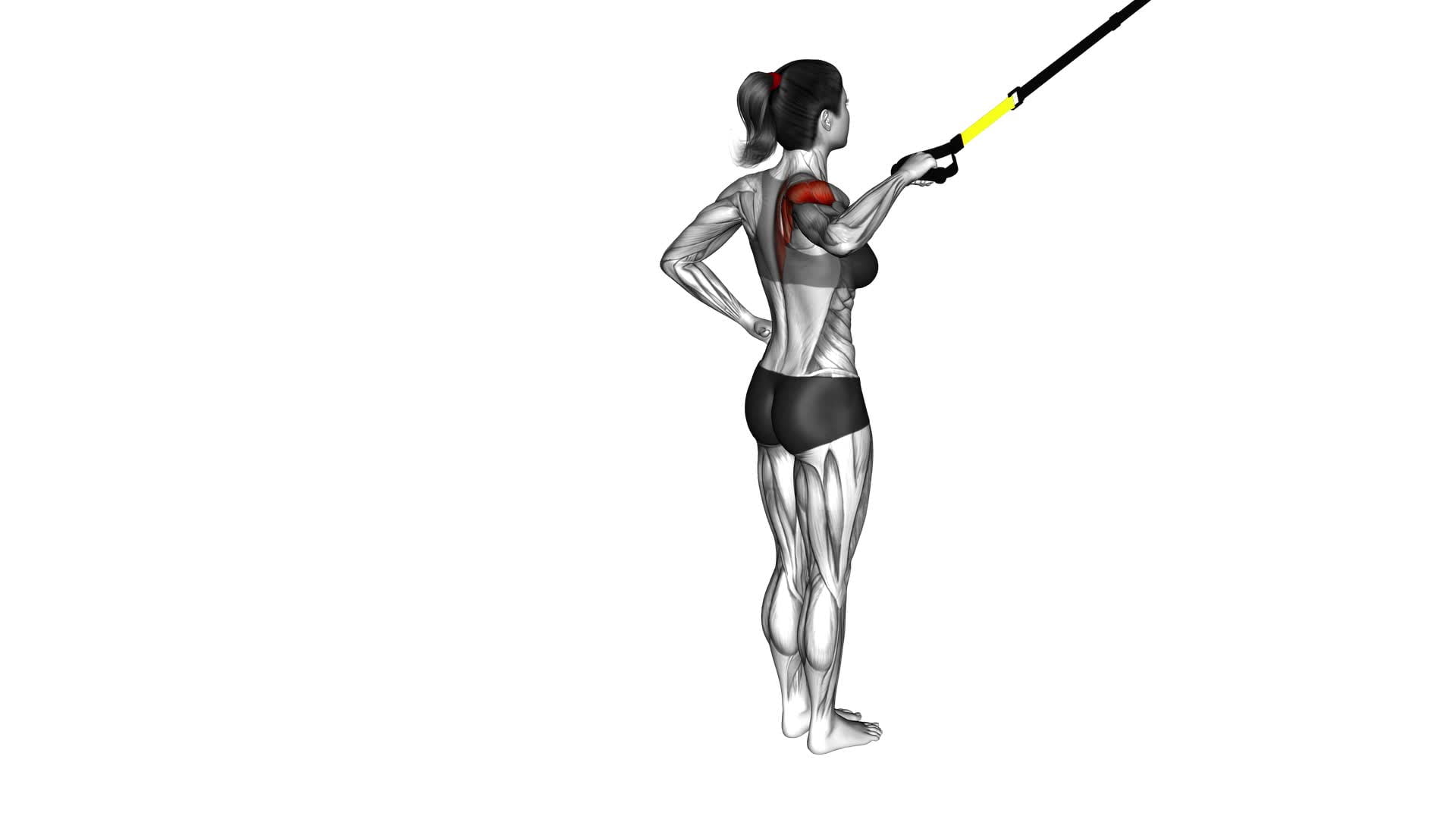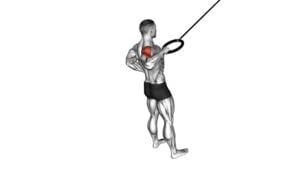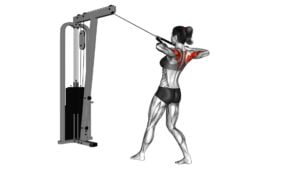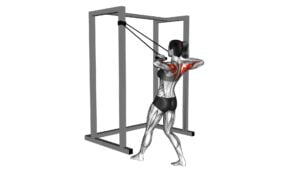Suspender Single Arm Rear Delt Row (female) – Video Exercise Guide & Tips

Are you looking for a challenging and effective exercise to target your rear deltoid muscles? Look no further than the Suspender Single Arm Rear Delt Row!
Watch This Exercise Video
In this video exercise guide, we'll show you the proper form and technique to maximize your results. Whether you're a beginner or a seasoned fitness enthusiast, we've got modifications and progressions for all fitness levels.
Get ready to tone and strengthen your shoulders like never before.
Let's dive in and get started!
Key Takeaways
- Targets rear deltoid muscles responsible for shoulder extension and lateral rotation
- Improves posture and shoulder stability
- Increases overall upper body strength
- Helps correct muscle imbalances in the back
Benefits of the Suspender Single Arm Rear Delt Row
To maximize your workout, the Suspender Single Arm Rear Delt Row offers numerous benefits for strengthening and toning your back muscles. This exercise targets the rear delts, which are the muscles responsible for shoulder extension and lateral rotation. By incorporating this exercise into your routine, you can improve your posture, enhance your shoulder stability, and increase overall upper body strength.
One of the key benefits of the Suspender Single Arm Rear Delt Row is that it allows you to isolate and target the specific muscles in your back. By using a single arm, you can ensure that each side of your back is being worked evenly, helping to correct any imbalances that may exist. Additionally, the use of suspenders adds an element of instability, forcing your muscles to work harder to stabilize your body during the movement.
Variations of the Suspender Single Arm Rear Delt Row can also be incorporated to provide additional benefits. For example, you can adjust the angle of your body to target different areas of your back or use different grips to change the emphasis on specific muscles. You can also increase or decrease the weight or resistance to challenge your muscles in different ways.
Proper Form and Technique for the Exercise
For proper form and technique for the Suspender Single Arm Rear Delt Row exercise, start by positioning yourself correctly. This will ensure that you engage the targeted muscles effectively and minimize the risk of injury. Here's a step-by-step guide to help you get it right:
- Stand facing the suspension trainer with your feet shoulder-width apart.
- Avoid standing too close or too far away from the anchor point as it may compromise your stability and balance.
- Keep your core engaged and maintain a neutral spine throughout the exercise.
- Grasp the suspension trainer handle with one hand and extend your arm fully in front of you.
- Ensure that your wrist is in a neutral position to prevent strain on the joints.
- Maintain a slight bend in your elbow to avoid hyperextension.
- Initiate the movement by retracting your shoulder blade and pulling the handle towards your body.
- Focus on squeezing your shoulder blade and engaging your rear deltoids.
- Keep your elbow close to your side and avoid excessive swinging or twisting.
Common Mistakes to Avoid:
- Using momentum to complete the movement instead of relying on muscle strength.
- Allowing your shoulders to shrug or hunch forward, which reduces the effectiveness of the exercise.
- Overarching your lower back or rounding your shoulders, which can lead to strain or injury.
Equipment Needed for the Suspender Single Arm Rear Delt Row
You will need a suspension trainer for the Suspender Single Arm Rear Delt Row exercise. This equipment is essential to perform the exercise correctly and effectively. A suspension trainer consists of two straps with handles or foot cradles that can be adjusted to different lengths. It can be attached to a sturdy anchor point such as a door frame, pull-up bar, or a hook in the ceiling. The suspension trainer allows you to engage your core and stabilizer muscles while performing the exercise, adding an extra challenge to your workout.
The suspender row variations are a great way to target your rear deltoids, upper back, and biceps. However, if you don't have access to a suspension trainer, there are alternative exercises you can try to work the same muscle groups. Some alternatives include bent-over dumbbell rows, cable rows, or resistance band rows. These exercises can be done with minimal equipment and still provide a similar benefit to the rear delt row.
Now that you know the equipment needed for the Suspender Single Arm Rear Delt Row, let's move on to the next section where we'll discuss modifications and progressions for all fitness levels. These modifications will help you adjust the exercise to your current fitness level and gradually increase the difficulty as you become stronger.
Modifications and Progressions for All Fitness Levels
Continuing from the previous subtopic, adjust the Suspender Single Arm Rear Delt Row exercise to your fitness level and gradually increase the difficulty. This exercise can be modified and progressed to suit individuals of all fitness levels. Here are some modifications and progressions you can try:
Modifications:
- Use lighter weights or resistance bands: If you're a beginner or have limited upper body strength, using lighter weights or resistance bands can help make the exercise more manageable.
- Perform the exercise seated: If standing is challenging for you, try performing the exercise while seated on a bench or stability ball. This can provide additional support and stability.
Progressions:
- Increase the weight or resistance: As your strength improves, gradually increase the weight or resistance used in the exercise. This will challenge your muscles and help you progress.
- Perform the exercise on unstable surfaces: Introduce instability by performing the exercise on a balance board or stability ball. This will engage your core muscles and add an extra level of difficulty.
Remember to listen to your body and adjust the exercise accordingly. It's important to start with modifications and gradually progress to avoid injury and ensure continued improvement.
Tips for Maximizing Results and Avoiding Common Mistakes
To maximize your results and avoid common mistakes, it's important to focus on proper form and technique while performing the Suspender Single Arm Rear Delt Row exercise. This will help you maximize intensity and avoid injury.
First and foremost, make sure to maintain a strong and stable core throughout the exercise. Engage your abs and keep your back straight to prevent any strain on your lower back.
Secondly, pay attention to your shoulder positioning. Keep your shoulder blades retracted and depressed, avoiding any shrugging or hunching. This will ensure that you're targeting the rear deltoids effectively.
Additionally, it's important to use a weight that challenges you without compromising your form. Start with a lighter weight and gradually increase as you become more comfortable and confident with the exercise.
Lastly, avoid using momentum to perform the exercise. Focus on a slow and controlled movement, both during the rowing motion and the return to the starting position. This will maximize the effectiveness of the exercise and minimize the risk of injury.
Frequently Asked Questions
How Many Calories Does the Suspender Single Arm Rear Delt Row Burn?
The suspender single arm rear delt row is a great exercise for targeting your rear deltoids.
As for the number of calories burned, it depends on various factors such as your weight, intensity, and duration of the exercise. On average, you can expect to burn around 8-12 calories per minute with this exercise.
If you have a shoulder injury or are looking for alternatives, you can try seated rear delt rows or bent-over lateral raises.
Can I Do the Suspender Single Arm Rear Delt Row if I Have a Shoulder Injury?
If you have a shoulder injury, it's important to prioritize your recovery and avoid exercises that may worsen the condition. Instead of the Suspender Single Arm Rear Delt Row, which can put strain on the shoulder joint, focus on shoulder injury rehabilitation exercises that are specifically designed to improve strength and flexibility.
Modified exercises for shoulder injuries, such as resistance band exercises and isometric holds, can be beneficial in promoting healing and preventing further damage. Always consult with a healthcare professional for personalized advice.
How Often Should I Perform the Suspender Single Arm Rear Delt Row for Optimal Results?
To achieve optimal results with the Suspender Single Arm Rear Delt Row, it's crucial to perform it with proper form and at the right frequency. By engaging the rear deltoids, this exercise helps improve posture and upper body strength.
To achieve optimal frequency, aim to include this exercise in your routine 2-3 times per week, allowing for adequate rest and recovery in between sessions. Remember to maintain proper form throughout, focusing on squeezing your shoulder blades together and keeping a stable core.
Can I Use Resistance Bands Instead of Suspenders for This Exercise?
Yes, you can definitely use resistance bands instead of suspenders for the suspender single arm rear delt row exercise.
Using resistance bands offers several benefits for this exercise. They provide constant tension throughout the movement, helping to engage your muscles more effectively.
Additionally, resistance bands are portable and versatile, allowing you to perform this exercise anywhere.
Are There Any Alternatives to the Suspender Single Arm Rear Delt Row That Work the Same Muscles?
Looking for alternatives to the suspender single arm rear delt row that target the same muscles?
There are a few variations of rear delt exercises that you can try. One option is the bent over dumbbell row, which works the rear delts along with other back muscles.
Another option is the face pull, which specifically targets the rear delts and upper back.
These exercises can provide similar benefits to the suspender single arm rear delt row.
Conclusion
In conclusion, the Suspender Single Arm Rear Delt Row is a highly effective exercise for targeting the rear deltoid muscles. By using proper form and technique, along with the right equipment, individuals can maximize their results and avoid common mistakes.
This exercise can be modified and progressed to suit all fitness levels, making it a versatile option for anyone looking to strengthen and tone their shoulders.
Incorporating this exercise into your workout routine can help you achieve your fitness goals.

Author
Years ago, the spark of my life’s passion ignited in my mind the moment I stepped into the local gym for the first time. The inaugural bead of perspiration, the initial endeavor, the very first surge of endorphins, and a sense of pride that washed over me post-workout marked the beginning of my deep-seated interest in strength sports, fitness, and sports nutrition. This very curiosity blossomed rapidly into a profound fascination, propelling me to earn a Master’s degree in Physical Education from the Academy of Physical Education in Krakow, followed by a Sports Manager diploma from the Jagiellonian University. My journey of growth led me to gain more specialized qualifications, such as being a certified personal trainer with a focus on sports dietetics, a lifeguard, and an instructor for wellness and corrective gymnastics. Theoretical knowledge paired seamlessly with practical experience, reinforcing my belief that the transformation of individuals under my guidance was also a reflection of my personal growth. This belief holds true even today. Each day, I strive to push the boundaries and explore new realms. These realms gently elevate me to greater heights. The unique combination of passion for my field and the continuous quest for growth fuels my drive to break new ground.







